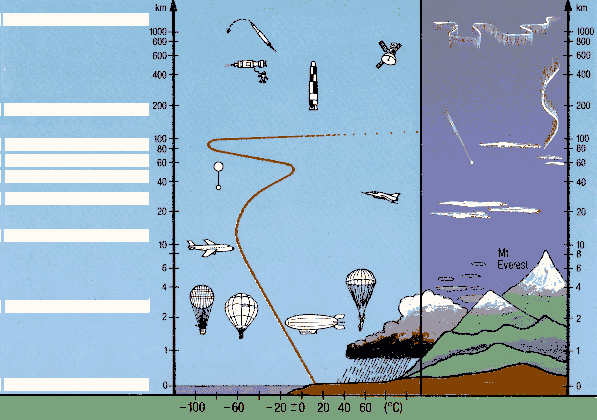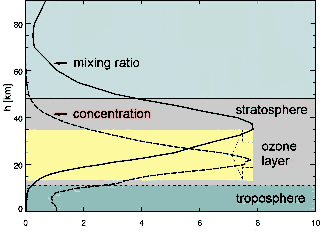|
|
 |
|
We divide the atmosphere into different layers. These layers all have different characteristics. For example, different layers have different temperature trends, different radiation budgets and different chemical characteristics. This worksheet will help you identify which part of the atmosphere is which.
|
 |
 |
|
1. The Earth's atmosphere and its layers
© 2003 Seesing, Tausch; Universität-Duisburg-Essen, Duisburg
|
The Earth's atmosphere and its layers
|
T1 |
Read the texts in this unit and then fill in the white boxes using the words below:
mesosphere, troposphere, sea level, stratosphere, stratopause, thermosphere, mesopause, tropopause |
|
T2 |
Draw on the position of the ozone layer in two different ways:
1. based on the postion of the high ozone concentation in the graph below.
2. based on the high values for the ozone mixing ratio.
Both ranges should be distinguishable, although they overlap themselves! |
|
Ozone in the ozone layer protects us against dangerous ultra-violet radiation from the Sun. Ozone absorbs the ultra-violet radiation, converts it into heat and therefore prevents it from reaching the Earth.
|
|
 |
 |
|
2. Ozone profiles (IUP Bremen).
Please click to enlarge!
|
|
 |
|
T3 |
Ozone concentrations (e.g µg/m³) and mixing ratios (e.g.: %, ppm) are two different ways of measuring the amounts of ozone in the atmosphere. Which of the two graphs best resembles the temperature profile in the stratosphere? Explain your answer briefly based on the locations of the maximum values. | |
About this page:
authors: M. Seesing, M. Tausch - Universität Duisburg-Essen, Duisburg, Germany
scientific reviewing: Dr. John Crowley, Max Planck Institute for Chemistry, Mainz - 2004-05-04
last update: 2004-05-24
|
|
 |
|







